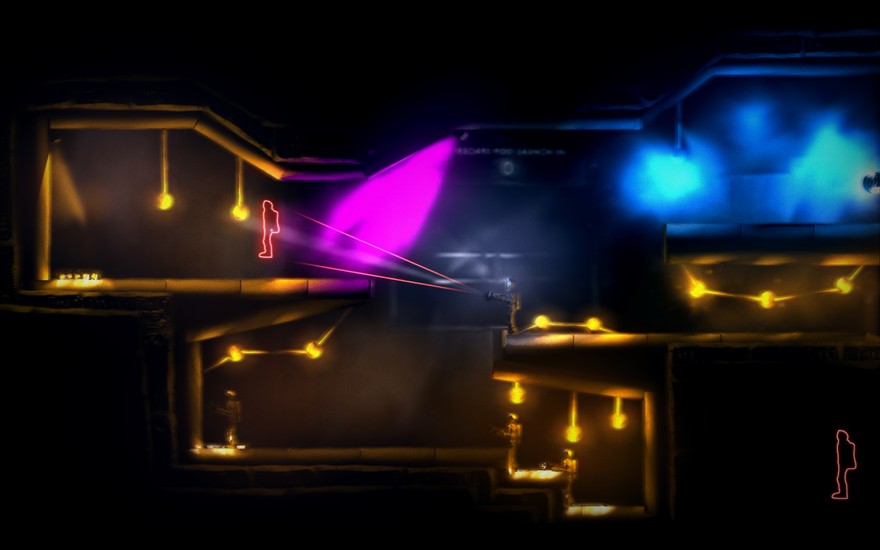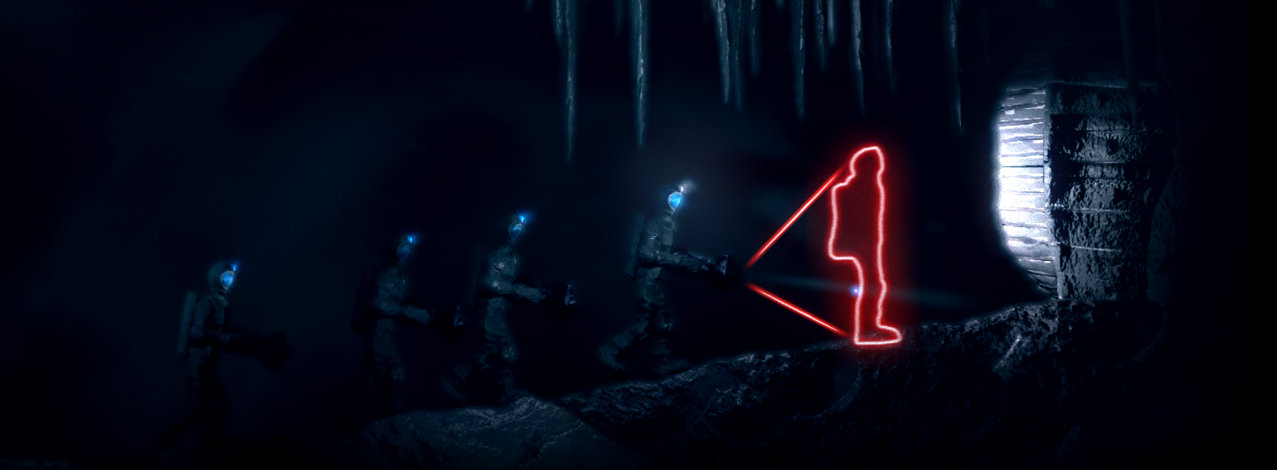“Health is the ability to stand in the spaces between realities without losing any of them—the capacity to feel like one self while being many.” – Bromberg, 1993, p. 166
The above quote is not from The Swapper—Facepalm Games’ existential space puzzler recently ported to the PS4—but it could have been. As you go about your business on the game’s (mostly) empty space station, you regularly pass by strange rock formations known as “Watchers,” an ancient race of hive-minded telepaths. Through brief, cryptic transmissions that appear on the screen, you begin to piece together the calamitous events that occurred when Watchers were first discovered by humans a decade before the events of the game. There is a fundamental misunderstanding between Watcher and human culture: namely, the Watchers are baffled by our claim to individuality—that every person has a unique and separate consciousness—as they conceive themselves as part of a “great chain” in which the one cannot be meaningfully separated from the many.
In this way, The Swapper is on the vanguard of games grappling with what it means to be ourselves—a concept that has gone under radical revision in recent years, due in large part to developments in contemporary psychoanalysis.
///
Many readers might be only vaguely aware of “psychoanalysis” as the weird creation of someone name Freud at the turn of the 20th century. For reasons too numerous to go into here, the notion that psychoanalysis is dead, debunked, and irrelevant has become a popular narrative, particularly in the United States, despite being untrue. (Those interested in knowing more should start with this article.) In fact, much of the way Western society thinks about itself remains greatly influenced by psychoanalysis, though most are not aware of it—appropriately enough, considering psychoanalysis is in large part the study of the unconscious.
In the United States of the mid-20th century, a particularly dogmatic and conservative variant of psychoanalysis known as “ego psychology” was the major force guiding how medicine, and by extension the broader culture, thought about both healthy and troubled minds. At the heart of this perspective was the idea that each person has a core self which is constantly being pulled in conflicting directions due to pressures from the outside world, internal desires, and moral conscience. This core self was referred to as the “ego.” The role of psychoanalysis as a treatment, therefore, was to reinforce the ego much in the way you might reinforce a building: you get “better” by strengthening your ability to weather the various inner and outer conflicts generated by daily living. From this perspective, the self is a centered, unified structure that needs protection from the disintegrating influences of reality and the unconscious.
Perhaps unsurprisingly, this concept really clicked with Americans. Ego psychology was selling the same line on which the country was founded: Every man is an island, who, through hard work and determination, can acquire the power to master both his environment and his inner struggles. (Women were not considered much in the sculpting of ego psychology or the American dream.) It was a fantasy of linear progression, equating change with positive improvement. If this strikes some as familiar, even implicit to how we think about change, it’s because it is. The strong, unified self that always moves forward and never falters back is deeply entrenched in our modern mythology: our politics, our healthcare, our literature and films … and our games.
///
Think of some of the biggest videogame characters, particularly those by Western developers: Lara Croft, Commander Shepard, Rayman, Master Chief. They all start with certain core, immutable abilities and over the course of the game achieve new skills, powers, weapons, and so on—they never get a little better in some ways and a little worse in others, or change in a lateral direction so that it’s up to players to determine if they have really progressed or not. The formula is simple: The character powers up, the environment becomes more challenging, and then the character powers up again. This approach to progression in videogames is incredibly common, and reflects a long-standing, largely unconscious cultural attachment to the idea of the unified self. A major reason why we find this formula so fun is that it adheres to the aforementioned fantasy that we get better one step at a time, and that once we have gained something we are not at risk of losing it.

One interesting exception can be found in Mario. Throughout Super Mario Bros. and most subsequent sequels, Mario neither stays the same nor changes in a linear fashion. Instead, he goes through regular state shifts between Big Mario (who is strong enough to break blocks and can take a hit from a Goomba), Little Mario (who is physically weaker and more vulnerable but can fit in tight spaces), and specialized variants which can be either extremely or barely useful depending on the context of the level (there is nothing more frustrating than seeing a flower sprout up in Super Mario Bros. 3 when you really wanted that feather).
“Self-states” is a major theme in contemporary psychoanalysis, which, since the 1980s, has reemerged as a more subversive and socially progressive movement in reaction to the conservative dogma of mid-20th century ego psychology. Philip Bromberg, quoted at the top of this article, has written extensively about how the theory of a unified, linear self simply does not match the empirical evidence readily observable in how a modern person thinks, feels, and engages with the world. Building off of other important psychoanalytic theorists such as D.W. Winnicott, Jacques Lacan, and Thomas Ogden, Bromberg’s work centers around the idea that our sense of being a single, integrated human being is a healthy illusion, but an illusion nonetheless.
In fact, Bromberg would say that we are less a singular person than an assemblage of states in constant communication with one another, and that we move about fluidly through these states, often without thought. Context plays a major role in determining our present state: things like the presence of others (are we alone, with close friends, in a crowd?), our physiological state (are we hungry, tired, caffeinated?), and the emotional content of the moment (so overwhelming we dissociate? So engaging we lose our normal sense of time?). Modern neuroscience increasingly supports this notion that we are not one self but many selves able to feel like one: while we each have one solid brain to our name, brain-scanning research demonstrates that which systems come online is greatly dependent on the state we are in (physiological, psychological, environmental) at any given moment.
///
In The Swapper, you make clones of yourself (up to four at a time) and move between them in order to collect orbs in increasingly hard-to-reach places. It is a clever mechanic that is very fun in its own right, requiring serious spatial reasoning and advance planning.

But The Swapper transcends being “just” a puzzle game by making its setting and themes so gritty and tactile (aided by the use of physical clay models as backgrounds and character models). You can never fully treat the game as an abstract puzzler: there is always an awareness that you are creating multiple selves, swapping between them, and then collapsing back into one. Encounters with the Watchers lend an uneasiness to the whole ordeal: on the one hand, they appear to be an advanced, even enlightened society, but at the same time they are responsible for the deaths of nearly all the humans aboard the space station. Using the swapper device seems to be the closest a human can experience to traversing the “great chain” that the Watchers speak of with such reverence. But as things progress, the nature of the device becomes less clear-cut. Who do you become when you swap into a clone? Who do you destroy when the level ends and all your copies collapse into lifeless heaps before dissolving entirely?
Solving the game’s puzzles requires the consideration of context, which as I stated above is often under-represented in game design. You and a clone are the same in one respect—your movements are identical—but in another respect who you are is inextricably tied to the space you inhabit within the level. Moving slightly to the left might be meaningless for you but will send a clone plummeting to her death. You might be bathed in frustratingly swap-resistant purple light, effectively paralyzed, while one clone stands very usefully in reverse gravity on the floor-button that opens the gate to an orb. Next to the orb is another clone ready to grab it—if only you could figure out how to swap there.

It is in these moments that The Swapper is truly fascinating, as it demands not only that you consider context but multiple contexts of your multiple selves all at once. Right now you might be the “you” who is on the ground, but eventually you want to be the you who is standing on an elevated platform, next to an orb. The game is deliberately ambiguous in differentiating these two selves; you are left to decide whether your clone has the same thoughts and desires that you have, or is just an empty shell waiting to be swapped into. And when the orb is obtained and you become one corpus again, only your gut feeling can tell you if something has been lost, or, as might be proffered by “self-state” theory, the pieces of yourself that were temporarily felt as separate have simply reintegrated into the illusion of a whole.
The fact that the story of The Swapper centers around the clash between the “multiple” Watchers and “unified” humans is in and of itself a useful metaphor for where we stand as a culture on this subject. Scholars, scientists, and artists are still wrestling with which narrative of the self we want to accept as “real.” There may never be one satisfying answer to this debate. One of the great paradoxes of human nature is, as Bromberg suggests, that we are strangely capable of being both one and many at the same time. Regardless, it is exciting to see videogames approach such complex psychological phenomena—while still being a blast to play, I might add.
Mario image from Mike Seidman
